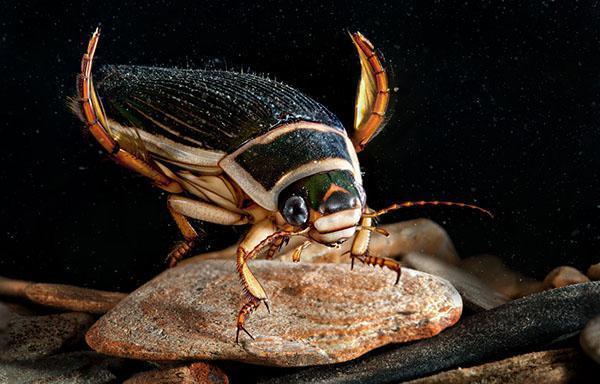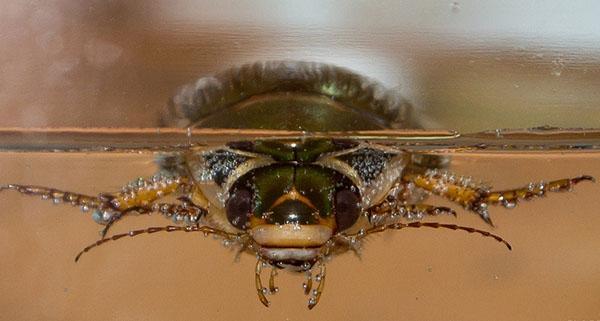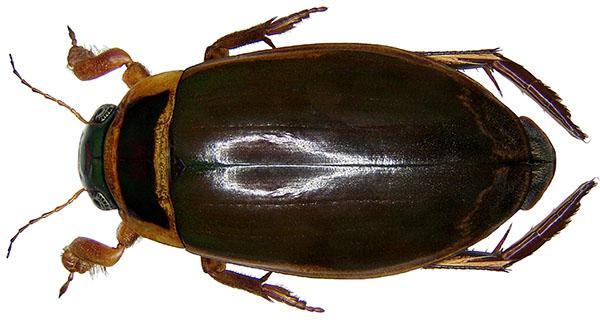A predatory inhabitant of fresh water bodies - beetle diving beetle
 a quiet river backwater among thickets of duckweed and reeds, you can often see a dark brown beetle with a smooth oval body. It floats on the water, exposing the end of the abdomen to the surface, and then dives deeper, releasing an air bubble. This is a swimming beetle, one of the many representatives of the order of beetles.
a quiet river backwater among thickets of duckweed and reeds, you can often see a dark brown beetle with a smooth oval body. It floats on the water, exposing the end of the abdomen to the surface, and then dives deeper, releasing an air bubble. This is a swimming beetle, one of the many representatives of the order of beetles.
Insect description

 The oval body of the diver is perfectly adapted for movement under water. The beetle has powerful hind legs covered with mobile hairs. In the water, he rakes them at the same time, like oars. The middle pair of legs serves to change the direction up or down. The body structure is typical for insects: head, chest and abdomen.
The oval body of the diver is perfectly adapted for movement under water. The beetle has powerful hind legs covered with mobile hairs. In the water, he rakes them at the same time, like oars. The middle pair of legs serves to change the direction up or down. The body structure is typical for insects: head, chest and abdomen.
 The flat, wide head merges smoothly into the chest. On the sides are complex compound eyes, consisting of 9 thousand simple eyes. The powerful lower jaw is designed to grip and chew food. The mouth apparatus of gnawing type swimmers. Long antennae, divided into segments, act as the organ of smell. These anatomical features are clearly visible on the photo of a swimming beetle in macro mode.
The flat, wide head merges smoothly into the chest. On the sides are complex compound eyes, consisting of 9 thousand simple eyes. The powerful lower jaw is designed to grip and chew food. The mouth apparatus of gnawing type swimmers. Long antennae, divided into segments, act as the organ of smell. These anatomical features are clearly visible on the photo of a swimming beetle in macro mode.
 The abdomen of the insect consists of segments, covered with rigid smooth elytra. In some species, a light stripe runs along the edges of the body. The color of the beetle is dark - brown-green, gray-brown or black.
The abdomen of the insect consists of segments, covered with rigid smooth elytra. In some species, a light stripe runs along the edges of the body. The color of the beetle is dark - brown-green, gray-brown or black.
On the territory of Russia, two types of swimming beetles are most often found - edged and wide. Read the same about the May beetle and how to deal with it.
Lifestyle and feeding habits of the swimming beetle
 Despite the fact that these insects spend a significant part of the time in the water column, they breathe air, which enters the body through the spiracles located on the sides of the abdomen. From the spiracles, tracheal tubes pass through the entire body of the beetle, and respiratory sacs are located in the chest. The movement of air in the trachea is created by the rhythmic actions of the abdomen. To replenish the air supply, the diving beetle exposes the back of the abdomen above the water. One portion of air is enough for him for 8-10 minutes.
Despite the fact that these insects spend a significant part of the time in the water column, they breathe air, which enters the body through the spiracles located on the sides of the abdomen. From the spiracles, tracheal tubes pass through the entire body of the beetle, and respiratory sacs are located in the chest. The movement of air in the trachea is created by the rhythmic actions of the abdomen. To replenish the air supply, the diving beetle exposes the back of the abdomen above the water. One portion of air is enough for him for 8-10 minutes.
The body of the beetle is lighter than water, so it is easy for it to float to the surface. More effort is required to dive in and stay on the bottom. To do this, the diving beetle clings to stones or plants with hooks at the ends of the legs. At night, these insects are active, they hunt and make long flights in search of new food.
Before the start of the flight, the beetle goes to land, empties the intestines and fills the respiratory sacs with air. As a result, the weight is significantly reduced and the insect can take off. In search of a new reservoir, swimmers are guided by the shine of the water surface and often die, having made a hard landing on various shiny objects - a metal roof, cars, glass greenhouse or window.
Diving beetles hibernate, burrowing into the ground, in silt at the bottom of a reservoir, or under leaf litter. They are hunted by birds, fish, crayfish and small mammals.The insect leads a predatory life.
 The swimming beetle feeds on everything that can hold and gnaw its powerful jaws. He catches and eats snails, tadpoles, medium-sized insects and their larvae, eggs laid in shallow water. In a hungry state, it can attack prey, which is several times larger than itself - frogs, newts.
The swimming beetle feeds on everything that can hold and gnaw its powerful jaws. He catches and eats snails, tadpoles, medium-sized insects and their larvae, eggs laid in shallow water. In a hungry state, it can attack prey, which is several times larger than itself - frogs, newts.
His favorite food is fish fry. Thus, the swimming beetle is able to lime all the fish in the reservoir. In fish farms, the population is carefully monitored, leaving for him the role of an orderly, destroying the weak and sick livestock.
Breeding swimmers
 The sex difference in beetles is expressed in the size and structure of the legs. The female is larger, and the male has plates on the first three segments of the legs, with the help of which he holds the female during the mating period. For swimmers, it occurs in the spring. After fertilization, the female lays eggs in the bottom silt or plant tissues. The larvae hatch after 2 weeks. Outwardly, they look like caterpillars with powerful mandibles and a tail lifted up.
The sex difference in beetles is expressed in the size and structure of the legs. The female is larger, and the male has plates on the first three segments of the legs, with the help of which he holds the female during the mating period. For swimmers, it occurs in the spring. After fertilization, the female lays eggs in the bottom silt or plant tissues. The larvae hatch after 2 weeks. Outwardly, they look like caterpillars with powerful mandibles and a tail lifted up.
The larva is very voracious, and in large quantities destroys eggs, fry and larvae of other insects - mosquitoes, dragonflies, caddis flies. The digestive system is peculiar - the predator sticks its jaw into the body of the victim and injects gastric juice, which paralyzes the prey and quickly softens the tissues. The insect then sucks in the semi-digested contents.
 Before becoming an adult, the larva passes the pupal stage. At the beginning of autumn, she gets out of the reservoir and builds a cradle on the shore from lumps of soil and plant remains, in which pupation takes place. This process takes about a month. A few hours after the pupa leaves the cradle, the soft integument darkens and becomes harder.
Before becoming an adult, the larva passes the pupal stage. At the beginning of autumn, she gets out of the reservoir and builds a cradle on the shore from lumps of soil and plant remains, in which pupation takes place. This process takes about a month. A few hours after the pupa leaves the cradle, the soft integument darkens and becomes harder.
The swimming beetle is not difficult to keep in your home aquarium. Meat or fish is fine as food. It is better to keep the ornamental fish separately, as sooner or later the beetle will try them out anyway.